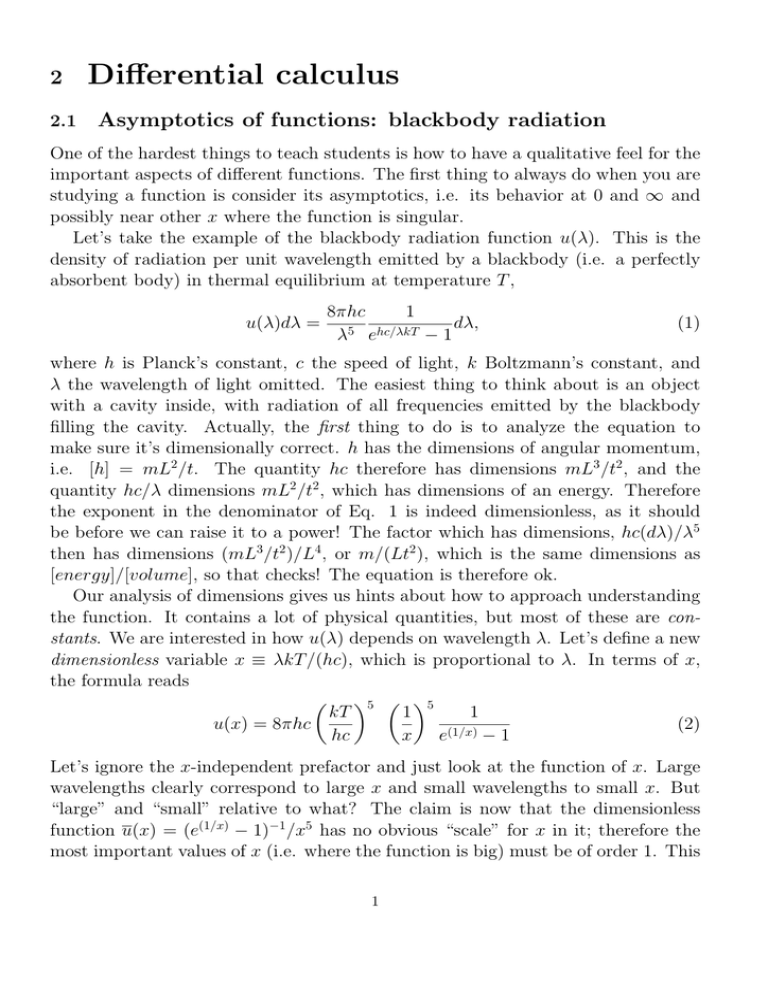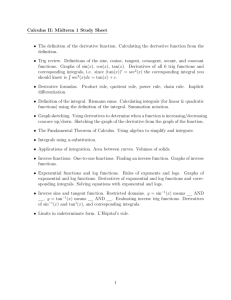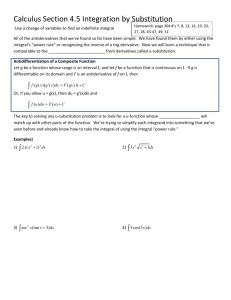Differential calculus 2 Asymptotics of functions: blackbody radiation
advertisement

2
2.1
Differential calculus
Asymptotics of functions: blackbody radiation
One of the hardest things to teach students is how to have a qualitative feel for the
important aspects of different functions. The first thing to always do when you are
studying a function is consider its asymptotics, i.e. its behavior at 0 and ∞ and
possibly near other x where the function is singular.
Let’s take the example of the blackbody radiation function u(λ). This is the
density of radiation per unit wavelength emitted by a blackbody (i.e. a perfectly
absorbent body) in thermal equilibrium at temperature T ,
u(λ)dλ =
8πhc
1
dλ,
λ5 ehc/λkT − 1
(1)
where h is Planck’s constant, c the speed of light, k Boltzmann’s constant, and
λ the wavelength of light omitted. The easiest thing to think about is an object
with a cavity inside, with radiation of all frequencies emitted by the blackbody
filling the cavity. Actually, the first thing to do is to analyze the equation to
make sure it’s dimensionally correct. h has the dimensions of angular momentum,
i.e. [h] = mL2 /t. The quantity hc therefore has dimensions mL3 /t2 , and the
quantity hc/λ dimensions mL2 /t2 , which has dimensions of an energy. Therefore
the exponent in the denominator of Eq. 1 is indeed dimensionless, as it should
be before we can raise it to a power! The factor which has dimensions, hc(dλ)/λ5
then has dimensions (mL3 /t2 )/L4 , or m/(Lt2 ), which is the same dimensions as
[energy]/[volume], so that checks! The equation is therefore ok.
Our analysis of dimensions gives us hints about how to approach understanding
the function. It contains a lot of physical quantities, but most of these are constants. We are interested in how u(λ) depends on wavelength λ. Let’s define a new
dimensionless variable x ≡ λkT /(hc), which is proportional to λ. In terms of x,
the formula reads
µ ¶5 µ ¶5
kT
1
1
u(x) = 8πhc
(2)
(1/x)
hc
x e
−1
Let’s ignore the x-independent prefactor and just look at the function of x. Large
wavelengths clearly correspond to large x and small wavelengths to small x. But
“large” and “small” relative to what? The claim is now that the dimensionless
function u(x) = (e(1/x) − 1)−1 /x5 has no obvious “scale” for x in it; therefore the
most important values of x (i.e. where the function is big) must be of order 1. This
1
may seem like an outlandish claim, so let’s check it. We can expand using a Taylor
expansion in either x or 1/x to find
½ −(1/x) 5
e
/x x ¿ 1
u=
(3)
1
xÀ1
x4
Figure 1: Energy density u of blackbody as function of reduced wavelength x, with asymptotic
short- and long-wavelength approximations.
Note a couple of tricks we used to obtain these results. In the x ¿ 1 limit,
the exponential is huge and dominates the 1 in the denominator, which can be
neglected. But the exp(−1/x) left over is divided by x5 . The numerator is going to
zero, denominator also–which wins? Of course formally we should use l’Hospital’s
rule: what you will find is that the derivatives of the power on the bottom get
bigger, but the derivatives on the top remain the same, hence the ratio indeed
approaches zero as x → 0. This is a special case of a general rule that when
exponentials and power laws compete, “exponentials always win!” (just as powers
always “win” over logs).
In the x À 1 limit, the exponential exp 1/x gets very close to 1, so we can expand
in powers of 1/x, exp 1/x ' 1 + 1/x + (1/x)2 /2 . . . . Hence the exp(1/x) − 1 ' 1/x
and we get the result in Eq. 3.
A full plot of the function, as seen in the figure, reveals in fact that there is a
peak around x = 0.2, which is indeed “of order 1”, i.e. not of order 10−1 or 101 .
As you see this criterion was pretty vague, because 0.2 is indeed closer to 0.1 than
to 1, but a physicist would say, “ok, well, it might be 1/2π, so if we take 2π equal
2
1 it works”. This may sound ludicrous, but it is simply the statement that there
is no other scale in the function. What do I mean by scale? Well, suppose I had a
function
g(x) =
1
(x − 10, 234)2 + 1
(4)
which cropped up in some problem. Then I would say, there is a scale, or dimensionless number 10,234 which is pretty important for the physics here for some reason.
In our blackbody problem, however, it doesn’t exist. The function is peaked near
x = 1.
Does this mean a blackbody always radiates with a maximum intensity at a
particular wavelength? Of course not. Depending on the temperature T , the λ for
which the maximum intensity is achieved can be quite different. To keep x ∼ 1, if
the temperature goes up the wavelength has to go down.
Figure 2: Energy density curve vs. wavelength in µm for different temperatures in Kelvin.
3
2.2
2.2.1
Some tricks for doing integrals
Differentiation with respect to a parameter
Suppose a function of x depends on a parameter a. Ex: sin ax. If an integral
converges, we can differentiate under the integral sign to obtain
Z x2
f (x, a)dx
(5)
F (a) =
x1
Z x2
∂F
∂f (x, a)
⇒
=
dx
(6)
∂a
∂a
x1
Rx
If you know F (a), you can derive results for the family of integrals x12 ∂ n f (x, a)/∂an dx.
Sometimes you know an integral and would like to use it to do a related, harder
integral; you can do so by introducing a parameter and differentiating with respect
to it.
R∞
Ex:R suppose you know or are given 0 (x2 + 1)−1 dx = π/2, but you want to
∞
know 0 (x2 + 1)−2 dx, which is not so obvious. Introduce
Z ∞
dx
I(a) =
,
(7)
2
x + a2
0
then express in terms of u = x/a:
1
I(a) =
a
Z
∞
0
du
π
=
.
u2 + 1 2a
Now differentiate the original expression:
Z ∞
∂I(a)
dx
=−
· 2a but also
∂a
(x2 + a2 )2
0
Z ∞
dx
⇒
−
· 2a
=
(x2 + a2 )2
0
Z ∞
dx
⇒
=
2
(x + a2 )2
0
(8)
∂I(a) ∂(π/(2a)
π
=
= − 2 (9)
∂a
∂a
2a
π
− 2
(10)
2a
π
.
(11)
4a3
Now note that the result holds for any value of a we like, so we could put a = 1 to
get
Z ∞
dx
π
=
,
(12)
2 + 1)2
(x
4
0
so in a pinch, e.g. if we were cast away on a desert island without tables of integrals
or the internet, we could in principle derive this result, or corresponding ones for
higher powers of the denominator, by taking further derivatives.
4
3
(2,1)
4
3
1
2
(0,0)
Figure 3: Paths from (0,0) to (2,1).
2.2.2
Integrals along a path
We consider the integral of a function of x and y along a path in 2-space (see Ch.
6, Sec. 8):
Ex. 1:
Z
I=
(2,1) ¡
xydx − y 2 dy
¢
(13)
(0,0)
from (0, 0) to (2, 1) along different paths as shown. The paths are
1. 1 straight line
2. parabola y = 14 x2
3. 2 straight lines along axes
4. x = 2t3 , y = t2 .
Q: Will the value of the line integral be the same along all paths?
A: No.
Path 1: y = x/2 ⇒ dy = 12 dx.
¶ Z 2
Z 2 µ
1
1
3
I1 =
dx x · x − (x/2)2 =
dx x2 = 1
2
2
8
0
0
5
(14)
R1
Path 3: 3a) [(0,0) to (0,1)] x = 0, dx = 0, I1a = − 0 y 2 dy = −1/3
R2
3b) [(0,1) to (2,1)] y = 1, dy = 0 so I3b = 0 x dx = 2.
So I3 = I3a + I3b = 5/3 6= I1 !
Paths: 2 & 4 – try yourselves before looking in book.
Ex. 2:
(0,1)
1
2
(-1,0)
(1,0)
(0,0)
Figure 4: Paths from (-1,0) to (1,0).
Find the integral
Z
J=
x dy − y dx
x2 + y 2
(15)
along the two paths shown.
1. Along semicircle: parameterize x = cos θ, y = sin θ. So
Z 0
xdy − ydx
= dθ ⇒ J =
dθ = −π
(16)
x2 + y 2
π
R
2. Along straight lines. Check yourself, using u2du+1 = tan−1 u. Should find
J1 = J2 .
2.3
Fun with partial differentiation (see Boas ch. 4)
Notation: for f = f (x, y),
µ
∂f
∂x
¶
(17)
y
6
is the partial derivative of f with respect to x with y held fixed (constant).
Ex. 1: f = x2 − y 2
x = r cos θ y = r sin θ
µ ¶
∂f
= 2x
∂x y
(18)
A little trickier: what is (∂f /∂x)θ or (∂f /∂θ)x ?
Method 1: express f in terms of x and θ first.
.
f = x2 − y 2 = x2 (1 − y 2 /x2 ) = x2 (1 − tan2 θ)
µ ¶
µ ¶
∂f
∂f
⇒
= 2x(1 − tan2 θ) 6=
∂x θ
∂x y
(19)
(20)
Method 2: (works in principle even if method 1 fails because you can’t solve for
f (x, θ) in closed form): use chain rule:
µ
µ ¶
¶
∂f
∂f
f = f (x, y) ⇒ df =
dx +
dy
∂x y
∂y x
in this case
df = 2x dx + 2y dy
but if we consider f = f (x, θ) then
µ ¶
µ ¶
∂f
∂f
df =
dx +
dθ
∂x θ
∂θ x
(21)
(22)
(23)
Now we need to compare (22) and (23). Now y = x tan θ, so dy can be expressed
in terms of x and θ as follows:
¶
µ ¶
∂y
∂y
dx +
dθ
dy =
∂x θ
∂θ x
= tan θ dx + x sec2 θ dθ.
µ
(24)
(25)
So putting these together we have
df = 2x dx + 2y dy
= 2x dx − 2y(tan θ dx + x sec2 θ dθ)
2
= 2x(1 − tan2 θ) dx −2x
tan
θ sec2 θ} dθ
{z
|
|
{z
}
µ ¶
µ ¶
∂f
∂f
∂x θ
∂θ x
7
(26)
(27)
(28)
(29)
¡ ¢−1
∂θ
Question and frequent source of confusion: is ∂x
= ∂x
? (In a situation
∂θ
where there is only one dependent variable this works, e.g take x = tan θ, θ =
tan−1 x, it is easy to show that dθ/dx = (dx/dθ)−1 .) But in general,
Answer: no, only true if the same variable is held constant in both cases. For
example,
µ ¶
∂x
∂x
x = r cos θ ⇒
(30)
= −r sin θ = −y so this is
∂θ
∂θ r
but also
∂θ
−y/x2
−y
−1 y
θ = tan
⇒
=
=
so this is
x
∂x 1 + y 2 /x2
r2
Since the same variable is not held constant, we do not find
2.3.1
µ
∂θ
∂x
∂θ
∂x
¶
=
(31)
y
¡ ∂x ¢−1
∂θ
.
Chain rule, implicit differentiation
2
d x
Ex. 2: Suppose x + ex = t. What is dx
dt ? dt2 ? If we could find x(t) explicitly, no
problem, but... we can’t. Use differentials:
dx
1
dx + ex dx = dt ⇒ (1 + ex )dx = dt ⇒
=
(32)
dt
1 + ex
To get second derivative, divide differential by dt and differentiate wrt t:
µ ¶2
2
dx
d2 x
x dx
xd x
x dx
=0
(33)
+e
=1 ⇒
+e 2 +e
dt
dt
dt2
dt
dt
d2 x
ex
solve to find
=−
(34)
dt2
(1 + ex )3
Ex 3:
If w = f (ax + by), show that
µ ¶
µ ¶
∂w
∂w
b
=a
.
∂x y
∂y x
Let u = ax + by. We have w = f (u),
µ ¶
∂w
=
∂x y
µ ¶
∂w
=
∂y x
(35)
so
∂f
∂f ∂u
=a
∂u ∂x
∂u
∂f
∂f ∂u
=b ,
∂u ∂y
∂u
so Eq. (35) follows.
8
(36)
(37)
2.3.2
Thermodynamics
“Equation of state”: f (p, V, T ) = 0, e.g. pV − RT = 0 (ideal gas law) or p − VRT
−b −
a
V 2 = 0 (van der Waals gas). Differential:
µ ¶
µ
¶
µ ¶
∂f
∂f
∂f
df =
dp +
dV +
dT = 0
(38)
∂p V,T
∂V p,T
∂T p,V
Now do 3 different experiments:
1. hold p fixed. dp = 0 so
¶
µ ¶
µ
∂f
∂f
dVp = −
dTp
∂V p,T
∂T V,p
³ ´
∂f
µ
¶
∂T p,V
∂V
1
= − ³ ´ = ¡ ∂T ¢
∂f
∂T p
∂V p
∂V
2. hold V fixed. dV = 0 so
µ
∂T
∂p
∂p
∂V
(40)
p,T
³ ´
¶
= −³
V
3. hold T fixed. dT = 0 so
µ
(39)
³
¶
∂f
∂p
∂f
∂T
∂f
∂V
´T,V = ³
p,V
∂f
∂p
∂p
∂T
(41)
V
´
p,T
= −³ ´
=³
T
1
´
T,V
1
∂V
∂p
´ .
(42)
T
Now examine product of two such derivatives, using above results
³ ´ ³ ´ ³ ´
∂f
∂f
∂f
µ
¶ µ
¶
∂V
∂T
∂T
∂V
∂p
p,T
p,V
p,V
= − ³ ´ − ³ ´ = ³ ´
∂f
∂f
∂f
∂V T ∂T p
∂p T,V
∂V p,T
∂p T,V
µ ¶
∂p
= −
.
∂T V
(43)
(44)
So independent of any particular equation of state f we always have relation among
partial derivatives
µ
¶ µ
¶ µ ¶
∂p
∂V
∂T
= −1
(45)
∂V T ∂T p ∂p V
9






